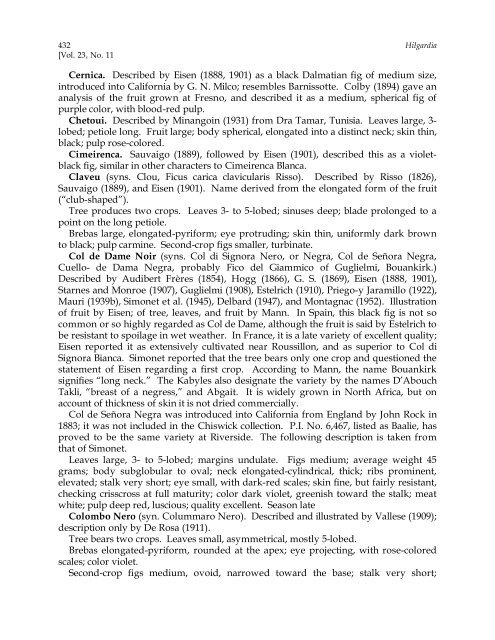Fig Varieties: A Monograph - uri=ucce.ucdavis
Fig Varieties: A Monograph - uri=ucce.ucdavis
Fig Varieties: A Monograph - uri=ucce.ucdavis
Create successful ePaper yourself
Turn your PDF publications into a flip-book with our unique Google optimized e-Paper software.
432 Hilgardia<br />
[Vol. 23, No. 11<br />
Cernica. Described by Eisen (1888, 1901) as a black Dalmatian fig of medium size,<br />
introduced into California by G. N. Milco; resembles Barnissotte. Colby (1894) gave an<br />
analysis of the fruit grown at Fresno, and described it as a medium, spherical fig of<br />
purple color, with blood-red pulp.<br />
Chetoui. Described by Minangoin (1931) from Dra Tamar, Tunisia. Leaves large, 3-<br />
lobed; petiole long. Fruit large; body spherical, elongated into a distinct neck; skin thin,<br />
black; pulp rose-colored.<br />
Cimeirenca. Sauvaigo (1889), followed by Eisen (1901), described this as a violetblack<br />
fig, similar in other characters to Cimeirenca Blanca.<br />
Claveu (syns. Clou, Ficus carica clavicularis Risso). Described by Risso (1826),<br />
Sauvaigo (1889), and Eisen (1901). Name derived from the elongated form of the fruit<br />
(“club-shaped”).<br />
Tree produces two crops. Leaves 3- to 5-lobed; sinuses deep; blade prolonged to a<br />
point on the long petiole.<br />
Brebas large, elongated-pyriform; eye protruding; skin thin, uniformly dark brown<br />
to black; pulp carmine. Second-crop figs smaller, turbinate.<br />
Col de Dame Noir (syns. Col di Signora Nero, or Negra, Col de Señora Negra,<br />
Cuello- de Dama Negra, probably Fico del Giammico of Guglielmi, Bouankirk.)<br />
Described by Audibert Frères (1854), Hogg (1866), G. S. (1869), Eisen (1888, 1901),<br />
Starnes and Monroe (1907), Guglielmi (1908), Estelrich (1910), Priego-y Jaramillo (1922),<br />
Mauri (1939b), Simonet et al. (1945), Delbard (1947), and Montagnac (1952). Illustration<br />
of fruit by Eisen; of tree, leaves, and fruit by Mann. In Spain, this black fig is not so<br />
common or so highly regarded as Col de Dame, although the fruit is said by Estelrich to<br />
be resistant to spoilage in wet weather. In France, it is a late variety of excellent quality;<br />
Eisen reported it as extensively cultivated near Roussillon, and as superior to Col di<br />
Signora Bianca. Simonet reported that the tree bears only one crop and questioned the<br />
statement of Eisen regarding a first crop. According to Mann, the name Bouankirk<br />
signifies “long neck.” The Kabyles also designate the variety by the names D’Abouch<br />
Takli, “breast of a negress,” and Abgait. It is widely grown in North Africa, but on<br />
account of thickness of skin it is not dried commercially.<br />
Col de Señora Negra was introduced into California from England by John Rock in<br />
1883; it was not included in the Chiswick collection. P.I. No. 6,467, listed as Baalie, has<br />
proved to be the same variety at Riverside. The following description is taken from<br />
that of Simonet.<br />
Leaves large, 3- to 5-lobed; margins undulate. <strong>Fig</strong>s medium; average weight 45<br />
grams; body subglobular to oval; neck elongated-cylindrical, thick; ribs prominent,<br />
elevated; stalk very short; eye small, with dark-red scales; skin fine, but fairly resistant,<br />
checking crisscross at full maturity; color dark violet, greenish toward the stalk; meat<br />
white; pulp deep red, luscious; quality excellent. Season late<br />
Colombo Nero (syn. Colummaro Nero). Described and illustrated by Vallese (1909);<br />
description only by De Rosa (1911).<br />
Tree bears two crops. Leaves small, asymmetrical, mostly 5-lobed.<br />
Brebas elongated-pyriform, rounded at the apex; eye projecting, with rose-colored<br />
scales; color violet.<br />
Second-crop figs medium, ovoid, narrowed toward the base; stalk very short;
















![Fig Trees in North Carolina [Archive] - IDigMyGarden ... - Figs 4 Fun](https://img.yumpu.com/26905320/1/190x245/fig-trees-in-north-carolina-archive-idigmygarden-figs-4-fun.jpg?quality=85)